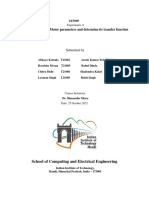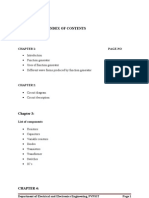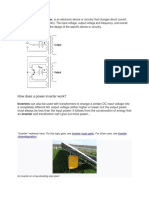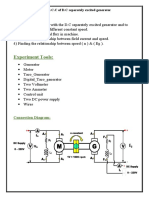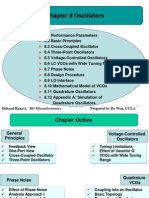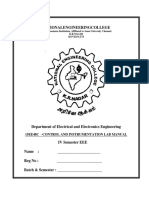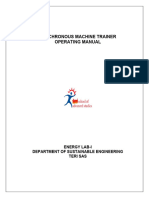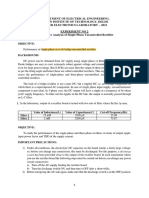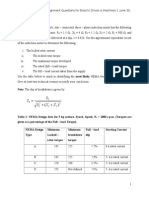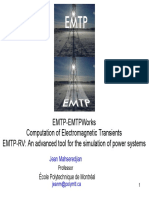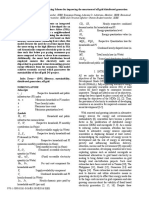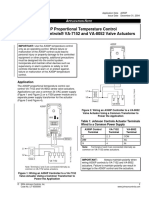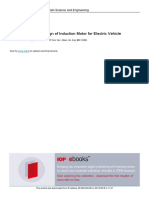Professional Documents
Culture Documents
DK1913 CH08
DK1913 CH08
Uploaded by
Maniraj PerumalOriginal Title
Copyright
Available Formats
Share this document
Did you find this document useful?
Is this content inappropriate?
Report this DocumentCopyright:
Available Formats
DK1913 CH08
DK1913 CH08
Uploaded by
Maniraj PerumalCopyright:
Available Formats
8
HARMONIC ANALYSIS
Until the 1960s the main harmonic sources in the power system were arc furnace
and a very few converter loads. With the thyristors and static power supplies many
variable speed drives were introduced in all industries in the 1970s. With the
increase in the converter load in the power system, several new problems became
noticeable such as:
• Flow of harmonic currents from the converter to the ac system.
• Poor power factor on the ac side.
• Poor voltage regulation on the ac side due to low power factor.
• Excessive interference induced into the telecommunication equipment due to
mutual coupling.
• Distortion of ac supply voltages that affects the performance of computer
equipment and numerical control devices.
• Error in the metering.
• Continuous neutral currents in the neutral conductors of the four wire systems.
Therefore, there is a need to understand the behavior of the industrial power
systems with the converter/inverter equipment. With the introduction of the new
filtering devices, the need to improve the power factor and control the harmonics
together in the utilities can encounter new system problems. In this Chapter, the
sources of harmonics, the system response, modeling of the system for harmonic
analysis, acceptable harmonic limits and the approach for the harmonic analysis are
presented.
Copyright 2002 by Marcel Dekker. All Rights Reserved.
8.1 HARMONIC SOURCES
There are several harmonic sources in the distribution systems. These are loads
with nonlinear characteristics. The converters, pulse width modulated converters,
cycloconverters, arc furnaces, static var compensators and switched mode power
supplies are typical nonlinear loads producing harmonics. The typical harmonic
frequencies and the corresponding magnitudes produced by various harmonic
producing equipment are listed below.
Converters - A typical six pulse converter is shown in Figure 8.1. This type of
ac to dc converter is used in variable speed drives, battery charging applications
and HVDC circuits. In the converter circuit each pair of thyristors is triggered
and conduct until they are reverse biased. If a thyristor is triggered at zero firing
angle, it acts exactly as a diode.
Va
L
O
A
D
Figure 8.1 Six Pulse Converter (1 through 6 - Thyristors)
An analysis will yield the following harmonic contents:
h=kq±l (8.1)
Ih = Ii/h (8.2)
Where h - Harmonic order
k - Any integer (0, 1, 2 ...)
q - Pulse number of the circuit
Ih - Magnitude of the harmonic component
Ii - Magnitude of the fundamental component
The harmonic contents of a six pulse converter are listed in Table 8.1 [1].
Copyright 2002 by Marcel Dekker. All Rights Reserved.
Table 8.1 Harmonic Contents of a Six Pulse Converter
h order Mag. Angle
1 100 -75
5 33.6 -156
7 1.6 -151
11 8.7 -131
13 1.2 54
17 4.5 -57
18 1.3 -226
23 2.7 17
25 1.2 149
Pulse Width Modulated (PWM) converters - PWM converters use power
electronic devices that can be turned on and turned off. The input power is usually
obtained from a converter source and the output voltage is shaped as per the
requirement using thyristor switching. The output pulse widths are varied to obtain
a three-phase voltage wave at the load. The load is usually ac motors used as
variable speed drives. The harmonic contents due to a typical PWM drive at
various load conditions are listed in Table 8.2 [1].
Table 8.2 Harmonic Contents of a PWM Drive
100% Load 75% Load 50% Load
h order Mag. Angle Mag. Angle Mag. Angle
1 100. 0 100. 0 100. 0
3 0.35 -159 0.59 -44 0.54 -96
5 60.82 -175 69.75 -174 75.09 -174
7 33.42 -172 47.03 -171 54.61 -171
9 0.5 158 0.32 -96 0.24 -102
11 3.84 166 6.86 17 14.65 16
13 7.74 -177 4.52 -178 1.95 71
15 0.41 135 0.37 -124 0.32 28
17 1.27 32 7.56 9 9.61 10
19 1.54 179 3.81 9 7.66 16
21 0.32 110 0.43 -163 0.43 95
23 1.08 38 2.59 11 0.94 -8
25 0.16 49 3.70 10 3.78 7
Copyright 2002 by Marcel Dekker. All Rights Reserved.
Cycloconverters - These are devices that convert ac power at one frequency to ac
power at a lower frequency. These converters are used to drive large ac motors at
lower speeds. These types of converters produce a significant amount of
harmonics. The harmonic components due to the operation of a cycloconverter are
given by:
fh=fi(kq ± l ) ± 6 n f 0 (8.3)
Where fh = Harmonic frequency imposed on ac system
k, n = Integers
fo = Output frequency of the cycloconverter
fi = Fundamental frequency of the ac system
Arc furnace - The harmonic produced by an electric arc furnace is very difficult to
predict due to the variation of the arc impedance on a cycle by cycle basis.
Therefore, the arc current is non-periodic and the analysis show both integer and
non-integer harmonic. The harmonic content is different both for melting and
refining periods. Table 8.3 presents the harmonic contents of the arc furnace
operation [1].
Table 8.3 Harmonic Contents of the Arc Furnace Current
Harmonic Order in %
Furnace Condition 1 2 3 4 5 7
Initial Melting 100 7.7 5.8 2.5 4.2 3.1
Refining 100 - 2.0 - 2.1 -
Static Var Compensator (SVC) - The thyristor controlled reactor with fixed
capacitors has been used to control the power factor of the electric arc furnaces and
similar distribution loads to reduce the voltage flicker. Since the thyristor controlled
reactor current is adjusted to correct the power factor, the harmonics are produced.
Typical harmonic components produced due to the operation of a static var
compensator are listed in Table 8.4 [1].
Switched mode power supplies - In all personal computers, the switched mode
power supplies are used. These are very economical designs in which energy is
stored in a capacitor and discharged in order to get a dc voltage through an
electronic circuit. Since the load seen by the ac side is capacitive, the current flow
is not continuous. The typical harmonic components due to a switched mode power
supply are shown in Table 8.5 [1].
Copyright 2002 by Marcel Dekker. All Rights Reserved.
Table 8.4 Maximum Harmonic Amplitudes due to a SVC
Harmonic Order Amplitude, % Harmonic Order Amplitude, %
1 100 3 13.78
5 5.05 7 2.59
9 1.57 11 1.05
13 0.75 15 0.57
17 0.44 19 0.35
21 0.29 23 0.24
25 0.20
Table 8.5 Harmonic Contents of a Switched Mode Power Supply
Harmonic Order Amplitude, % Harmonic Order Amplitude, %
1 100 3 81.0
5 60.6 7 37.0
9 15.7 11 2.40
13 6.30 15 7.90
8.2 SYSTEM RESPONSE TO HARMONICS
The effect of harmonics on the power system depends on the frequency response
characteristics of the system. Some of the important contributing factors are
discussed below.
System short circuit rating - A system with a large short circuit capacity will
produce a low voltage distortion. A system with a lower short circuit rating will
produce a large voltage distortion. The system short circuit rating depends on the
amount of generation, transmission voltage level, number of parallel lines and
other system characteristics.
Copyright 2002 by Marcel Dekker. All Rights Reserved.
Load characteristics - The resistive component of the load produces damping in
the circuit and hence reduces voltage magnification. The reactive component of the
load can shift the point at which the resonance occurs. Hence a reactive load can
amplify the voltage magnification. A lightly loaded system is likely to have less
damping and hence a higher voltage distortion. A heavily loaded system is likely to
offer a better damping.
Parallel resonance - A parallel resonance occurs when the system inductive
reactance and the capacitive reactance are equal at some frequency. If the resonant
frequency happens to coincide with a harmonic frequency of a nonlinear load, then
an oscillatory current flow will occur between the inductive source and the
capacitance. Such high oscillating current can cause voltage. A typical parallel
resonant circuit is shown in Figure 8.2. The resonant frequency is fo.
fo
Frequency
Figure 8.2 Parallel Resonant Circuit and Frequency Response
Series resonance - The series resonance is the result of the series combination of
the capacitor banks and the transformer inductance as shown in Figure 8.3. A series
resonant circuit offers a low impedance path for the harmonic currents and traps any
harmonic current at the tuned frequency. The series resonant circuit will cause
voltage distortion.
fo
Frequency
Figure 8.3 Series Resonant Circuit and the Frequency Response
The resonant frequency (fo) for both parallel and series resonance is given by
Equation 8.4.
Copyright 2002 by Marcel Dekker. All Rights Reserved.
f =
O , ^7 (8-4)
2 TiyL C
Where L is the circuit inductance and C is the capacitance. Both the parallel and
series resonance can cause oscillatory currents in the power system.
8.3 SYSTEM MODEL FOR COMPUTER-AIDED ANALYSIS
The power system can be modeled for analysis with the aid of harmonic analysis
programs. The available libraries include harmonic source data, cable data, line
data, transformer models and load data. The general data requirements can be
identified.
Source data - The required source data include node number, bus name, voltage
amplitude, angle. (Repeat the data for three phases).
Source impedance - The source impedance data are branch name, voltage, MVA
base, from node, to node for three phases, Rl, XI, RO, XO.
Transformer data - The transformer data include: transformer name, MVA,
voltage on high side, connection on high side, voltage on low side, connection on
low side, transformer impedance, %, node on high side for phase A, node on low
side for phase A. (Repeat the node names for three phases).
Line data - The required line data are line name, bus name, line length in miles.
Capacitor data - Capacitor name, bus name, 3-phase KVAR, voltage in kV.
Linear load data - Node name, voltage in kV, KVA, power factor.
Nonlinear load data - Node name, bus name, kV, KVA, % of peak load.
The data are prepared in order as per the program requirement and then executed to
get the output.
8.4 ACCEPTANCE CRITERIA
Power factor - When installing a filter bank for controlling the harmonic currents,
the capacitor banks improve the power factor of the system. Most utilities like the
customer to operate the load at a power factor of 95%. Sometimes, a better power
factor is prescribed.
Copyright 2002 by Marcel Dekker. All Rights Reserved.
Voltage distortion limits - The intent of IEEE Standard 519 is to show that the
power supplier is responsible for maintaining the quality of the voltage on the
power system. The acceptable voltage distortion limits for different system
voltage levels are presented in Table 8.6.
Table 8.6 Maximum Voltage Distortion Per IEEE Std. 519
Maximum Distortion System Voltage
(in %)
Below 69 kV 69-161kV > 161 kV
Individual Harmonic 3.0 1.5 1.0
Total Harmonic 5.0 2.5 1.5
For periods less than one hour/day increase limit by 50%
Current distortion limits - The IEEE Standard 519 intents that the customer be
responsible for keeping the current harmonic components within acceptable limits.
The current harmonic is defined in terms of the total demand distortion based on the
customer load demand. Faced with a proliferation of harmonic-producing loads,
utilities attempt to use IEEE 519 to limit harmonics from individual customers or
even individual loads. However, this approach has limitations because the voltage
distortion on the utility system is also a function of the system frequency response
characteristic, and harmonic sources from all customers. Total Demand
Distortion (TDD) is defined as:
H I.
TDD = (8.5)
h = 2 V L, demand
where IH is the harmonic current for a specific harmonic. Large customers face
stricter limits because they have more impact on voltage distortion. The
acceptable TDD is listed for system voltages less than 69 kV in Table 8.7. The
harmonic filters are designed using R-L-C components. The allowable overload
limits of the capacitors based on IEEE Standard 18, 1992 [5] are:
KVAR - 135%
RMS voltage = 110%.
Peak voltage = 120%
RMS current - 180%.
Copyright 2002 by Marcel Dekker. All Rights Reserved.
Table 8.7 Harmonic Current Limits in % From IEEE Std. 519
ISC/ILOAD Harmonic Order TDD
<11 11-16 17-22 23-24 >35
<20 4.0 2.0 1.5 0.6 0.3 5.0
20-50 7.0 3.5 2.5 1.0 0.5 8.0
50-100 10.0 4.5 4.0 1.5 0.7 12.0
100-1000 12.0 5.5 5.0 2.0 1.0 15.0
>1000 15.0 7.0 6.0 2.5 1.4 20.0
Where Isc = Maximum short circuit current at point of common coupling.
=
Itoad Maximum demand load current at fundamental frequency
TDD = Total demand distortion in % of maximum demand
For conditions lasting more than one hour/day. For shorter periods
increase the limit by 50%
8.5 HARMONIC FILTERS
Filtering the dominant harmonics can reduce the effect of harmonics. There are
several filters available to perform this function. The single tuned notch filter and
the high pass filter are two commonly used devices [1-3].
Single tuned filters - A single tuned or a notch filter can be used to filter
harmonics at a particular frequency. Figure 8.4 illustrates a common single tuned
notch filter to control a single harmonic. The impedance characteristics of the
filter are also shown in Figure 8.4. The following variables are used to describe
the filter.
2
MVARC = (8.6)
f
i
o - (8.7)
Xc
Q = (8.8)
R
Where MVARc = Rating of the filter bank
Xc = Reactance of the inductor
fo = Resonant frequency of the filter
Q = Q factor (typical value of 20 to 150)
Copyright 2002 by Marcel Dekker. All Rights Reserved.
R
fo
FREQUENCY
Figure 8.4 Single Tuned Filter With Frequency Response Characteristics
The tuned frequency and the operating point may change due to temperature,
tolerances and change in the supply frequency. But the single tuned filter is the
simplest device for harmonic control.
High pass filter - The frequency of the high pass filter, the optimal factor m, and
the MVAR of the capacitor bank are required. The MVARc is given by equation
(8.6). The other parameters are given by:
1
f
o - 2 7i CR
(8.9)
m = (8.10)
R2 C
fo is the resonant frequency and m is the optimal factor (1 to 3). A typical high
pass filter and the frequency response are shown in Figure 8.5. As can be seen
from the frequency response, the high pass filter reduces the impedance at high
harmonic orders to lower values. This filter is more efficient in reducing the
harmonics across the entire frequency spectrum.
Frequency —>
Figure 8.5 High Pass Filter and Frequency Response Characteristics
Copyright 2002 by Marcel Dekker. All Rights Reserved.
The high pass filter is not sensitive to the tuned frequency. This type of filter can
control harmonic frequencies over a wide range. The resistor produces
significant power loss at the fundamental frequency.
Multiple filter banks - Sometimes, there will be several dominant harmonic
frequencies in the system. In order to control harmonic frequencies such as 5
and 7th, single tuned filters will be used. In order to control 11th and higher
harmonic frequencies, a high pass filter will be used. Such an arrangement is
shown in Figure 8.6.
C1 C2 | C
Frequency
Figure 8.6 Multiple Filters and Frequency Response Characteristics
In this example, LI and Cl are responsible for controlling harmonics at a
specific frequency. Similarly L2 and C2 provide harmonic control at another
frequency. The L3, R and C3 combination is a high pass filter and provides
harmonic control over a wide range of frequencies.
The use of an inductor in series with a capacitor results in a voltage rise at the
capacitor terminals given by:
2
V,sys (8.11)
n2-!
Where n = Tuned impedance harmonic number of the frequency
Vsys = System line to line voltage, kV
Vc = Capacitor line to line voltage, kV
When a capacitor bank is used in a system at a voltage (kV), the available
MVARc is given by:
,2
kV'
MVAR C = (8.12)
Copyright 2002 by Marcel Dekker. All Rights Reserved.
Where Xc is the reactance of the capacitance bank. The presence of the filter
reactor changes the effective MVAR delivered. The output MVARfii ter of the
filter is:
kV 2
MVAR,.,
111 Id
= /"V "V \
(8.13)
(A c - A j )
Where Xi is the inductive reactance of the filter reactor.
8.6 HARMONIC EVALUATION
Total Harmonic Distortion (THD) of the Voltage - This is a commonly used
index in measuring the harmonic distortion in the voltage waveform and is
defined as:
2 2
K + v/ +v 4 + ..
THD = -^ vV, (8.14)
l
where ¥3, V^, V 4 ... Vn are individual rms harmonic voltage components and VI
is the fundamental frequency rms voltage. This is the ratio of the total rms value
of the harmonic voltages to the rms value of the fundamental component. The
voltage THD is important in industrial power systems since the voltage distortion
affects the other loads in parallel with harmonic producing load.
Total Demand Distortion (TDD) - The total demand distortion is the total
harmonic current distortion and is defined as:
2 2 2 2
f I 9 + K +I 4 +....In
TDD = — (8.15)
!
Load
where I?, 1$, U... In are the individual rms harmonic current components and Itoad is
the maximum load current at the point of common coupling.
Frequency domain analysis - The filters are added to the power system to
improve the power factor as well the harmonic performance. The addition of
shunt capacitors introduce resonance peaks in the system. The resonant harmonic
number (h) can be calculated using the equation:
Copyright 2002 by Marcel Dekker. All Rights Reserved.
(8.16)
V MVARc
where MVARs is the short circuit rating of the system and MVARc is the rating of
the shunt capacitor.
In a system with many components, the resonant peaks can be predicted using the
frequency scanning approach. By this method, one Ampere of current is injected at
the bus where the harmonic source is connected. The frequency domain
characteristics of the system are typically plotted up to 3,000 Hz. If the impedance
value at some harmonic h is less than 1.0, then the filters are attenuating currents at
that harmonic. If the impedance value is greater than 1.0, then the filters are
amplifying the harmonic. A near zero value on an amplification curve indicates a
series resonance (see Figure 8.3). This is the value where a filter branch is tuned to
provide maximum attenuation. A sharp maximum amplification curve indicates a
parallel resonance (see Figure 8.2). This occurs at a harmonic where the net
resonance of a filter branch is capacitive and equal in magnitude to the system or
transformer reactance. The network model is given by:
[Ysys] =[Q][Yprimitive][Q]T (8.17)
Where [Q] is the incidence matrix used to represent the network connectivity.
The frequency scan analysis is performed through repeated solutions of equation
(8.17) for each of the selected frequencies. Equation (8.16) provides a clear
frequency dependent version of the equation (8.15) where h is used to denote the
harmonic frequency in P.U.
[I h ] =[Y (h)][V(h)] (8.18)
An example showing the calculations are given below.
8.7 CASE STUDY
In order to demonstrate the harmonic analysis, a case study is presented based on a
practical system. Many details of the system are not presented, in order to make the
study easy to understand [4]. The harmonic analysis was performed using the
SuperHarm program from Electrotek Concepts [6].
A chemical plant is installing shunt capacitor banks in order to improve the
power factor and control the harmonics. This plant is supplied from a 69 kV
Copyright 2002 by Marcel Dekker. All Rights Reserved.
system from two different substations. A one-line diagram of the electrical system
of the plant is shown in Figure 8.7. The plant is supplied through two 20 MVA
step down transformers from the 69 kV system. These transformers supply
power to the plant through the 4.16 kV bus.
The plant load consists of several induction motors and variable speed motor
driven loads at 4.16 kV, 660 V and 480 V levels. Due to the operation of an
induction motor and variable speed drives, the system power factor is low.
Further, the measurements show that there are harmonic current flows at various
buses. The existing plant load is 12 MW and the operating power factor is 79%.
The required capacitor bank size is 6.6 MVAR.
'Source B
69 kV
20 MVA 20 MVA
4.16kV m
6.6 MVAR
Other Loads -±-
O
2x200hp 2x1250hp
ac
dc Motors Motors
Figure 8.7 Power System for the Case Study
The short circuit ratio corresponding to the maximum load current at the point of
common coupling is identified in Table 8.8.
Table 8.8 The Ratio of Isc/IL for the Plant
System Isc, A IL, A Isc/IL
Both sources are in service 15,031 100 150
Source A is out of service 12,347 100 123
Source B is out of service 8,416 100 84
The acceptable harmonic limits can be read from Tables 8.6 and 8.7.
Power factor correction - The average load of the plant is 12 MW. The
corresponding power factor is 79%. In order to correct the power factor to 97%
Copyright 2002 by Marcel Dekker. All Rights Reserved.
the required reactive power is 6.6 MVAR. The demand profile before and after
the power factor correction for a one-year duration is shown in Table 8.9. Also,
the effect of the shunt capacitors is to increase the power factor at maximum
demand conditions. At an average load of 12 MW, the power factor will be 97%
lagging. This meets the objective. The savings in maximum demand is of the
order of 3 MVA.
Table 8.9 Power Factor Values for Selected 6 Months
Existing With 6600 WAR WA
Month kW KVAR KVA PF KVAR KVA PF Savings
2 18594 13662 23074 0.81 7062 19890 0.93 3184
4 18918 13842 23441 0.81 7242 20257 0.93 3184
6 18655 13482 23017 0.81 6882 19884 0.94 3133
8 18414 13878 23058 0.80 7278 19800 0.93 3258
10 18522 13860 23134 0.80 7260 19894 0.93 3240
12 19206 14076 23812 0.81 7476 20610 0.93 3202
Filter design - The 5 harmonic is the dominant in the distribution system of the
plant. Therefore, in order to reduce the harmonic contents, the capacitor bank can
be tuned with suitable reactor as a fifth harmonic notch filter. The filter consists
of 490 MFD/phase capacitor banks with 0.3275 mH/phase inductor tuned to
4.7 harmonic frequency. The connection diagram of the filter circuit is shown in
Figure 8.8. The connection is wye, ungrounded in order to use the unbalance
detection scheme.
c
C
^
Va L
Vb
C
c\-
Unbalance ^~
Detector ^-
C
VC L r\.
c
C C
C
Figure 8.8 Fifth Harmonic Filter
Total harmonic distortion (THD) of the voltage - The calculated value of THD
of voltage and the acceptable values are presented in Table 8.10.
Copyright 2002 by Marcel Dekker. All Rights Reserved.
Table 8.10 Total Harmonic Distortion (THD) at PCC
Acceptable
Case Description THD, % THD, %
1 Both sources are present 0.84 5
2 Source A is out of service 0.86 5
3 Source B is out of service 1.22 5
4 Both sources are present + C 0.5 5
5 Source A is out of service + C 1.53 5
6 Source B is out of service + C 2.18 5
7 Both sources are present + filter 1.32 5
8 Source A is out of service + filter 1.32 5
9 Source B is out of service + filter 1.39 5
The THD of the voltage is acceptable in all the cases.
Total demand distortion - From the calculated harmonic currents, the TDD is
calculated for all 9 cases at the point of common coupling. The 5 and ?' harmonic
components are dominant and are compared with the allowed values in Table 8.11.
Table 8.11 Calculated TDD Components
TDD per IEEE 519 Compliance to
Case Fund 15 17 IEEE 519 TDD, % Value, % IEEE 5 19
1 6.52 3.04 12 7.25 15 Yes
2 6.38 2.99 10 7.09 12 Yes
3 6.30 2.93 10 6.99 12 Yes
4 11.71 8.36 12 14.40 15 Yes
5 11.44 8.13 10 14.05 12 No
6 11.86 7.74 10 14.17 12 No
7 1.75 2.08 12 2.81 15 Yes
8 1.70 2.04 10 2.75 12 Yes
9 1.57 1.94 10 2.58 12 Yes
From Table 8.11 it can be seen that without shunt capacitors, the individual
harmonic components and the TDD is within acceptable limits. With shunt
capacitors, the 5th harmonic level and the TDD is not acceptable. With the 4.71
harmonic filter, the TDD levels are acceptable.
Frequency scan analysis - There is no resonant frequency in the system without
power factor correction capacitors. With shunt capacitors for power factor
correction, the resonant frequency of the system is approximately 8f. This value
is in agreement with the calculated resonant frequency using equation (8.16).
Copyright 2002 by Marcel Dekker. All Rights Reserved.
With a 4.7th harmonic filter, the resonant frequency is 4.1 f. A frequency scan
result in which both the sources are present is shown in Figure 8.9. The system
should be able to operate satisfactorily with the notch filter.
0.25
0.20
I
O
o"
z
<
0.05
10 20 30 40 50 60
FREQUENCY, P.U.
Figure 8.9 Frequency Scan Result With Both the Sources Present
(Courtesy of Electrotek Concepts, Output from TOPS Program)
8.8 SUMMARY AND CONCLUSIONS
In this Chapter, the harmonic sources and the harmonic amplitudes are identified
from the system's operational point of view. The acceptable voltage distortion
and total demand distortion are presented from IEEE Standard 519. The
approach to correct both the power factor and limit the harmonics simultaneously
using filtering devices is discussed. The design of harmonic filters and approach
to assess the effectiveness of the system is also discussed. A practical example is
presented and the harmonics analysis using the frequency scan, voltage
magnification, voltage distortion and current demand distortion are illustrated.
Example 8.1 - A plant is supplied from a 69 kV system through a step down
transformer rated to 10 MVA, 69 kV/13.8 kV, delta/wye connected, 8.0%
impedance. The step down transformer of the customer is rated to 1 MVA, 13.8
kV/480 V, delta/wye connected and 6% impedance. The measured load current at
the 480 V level is 900 A. The measured 5th and 7th harmonic currents at the 480 V
level (due to converter load) is 100 A and 40 A respectively. Calculate the
following:
Copyright 2002 by Marcel Dekker. All Rights Reserved.
a) Short circuit current Isc at the point of common coupling at 13.8 kV level.
b) Short circuit current Isc at the point of common coupling at 480 V level.
c) Irms at the 480 V level.
d) TDD at 480 V level.
e) Distortion of 5 harmonic component.
f) Distortion of 7l harmonic component.
g) Isc/Iload at the PCC at 13.8 kV level. What is acceptable harmonic level?
h) Isc/Iload at the PCC at 480 V level. Is this harmonic level acceptable?
"+OU V
13.8RV hp
69 kV Nonlinear
r\ Circuit B reaker Load
^ £ \ *
* £ t
.A. \ -A.
I oad
TR1 1 TR2 |
•1 /~\ l\ ^\ / A I r—«^xx-v/-> k.
PCC1
Figure 8.10 Power System for Example 8.1
Solution -
Full load current of 10 MVA transformer
a) Isc =
Zof 10MVA transformer
10,000 kVA
I(fullload) = —7^ = 418 A
)(13.8kV)
418A
Isc (at 13.8 kV level) - = 5,225A
0.080
b) Isc at 480 V level
l,OOOkVA
I(fullloadat 480V) =-^ = 1,203 A
(^3~)(0.480kV)
1,203 A
Isc (at 480 V level) - = 20,050 A
0.060
c) Irms at 480V level
Irms (at 480 V level) = + I52 + I72 = 906.4 A
Copyright 2002 by Marcel Dekker. All Rights Reserved.
d) TDD at 480 V level
1002+402
TDD (at 480 V level) - 100 - 11.97%
900
e) Distortion of 5l harmonic component.
Distortion of 5th harmonic = 1 — 1 0 0 = 100 = 11.1%
I\ If xJ Ix900 xJ
f) Distortion of 7 harmonic component
Distortion of 7th harmonic = — 100 = 100 = 4.4%
(if) (900)
g) Isc/Iload at the PCC at 13.8 kV level. What is acceptable harmonic level?
I(loadat480V = 900A)(480V)
I (load at 13.8kV) = - = 31.3A
13,800
Isc 5,225 A
= 167
Iload 31.3
The acceptable TDD is 15% and for 5th and 7th harmonic it is 12% .
h) Isc/Iload at the PCC at 480 V level. Is this harmonic level acceptable?
Isc 20,050A
-(480 V level) = — = 22.3
Iload 900
The acceptable TDD is 8% and for 5th and 7th harmonic it is 7% at the 480 V level.
Harmonic Calculated Allowable Remarks
5 11.1% 7/)% Not acceptable
7th 4.4% 7.0% Acceptable
TDD 11.9% 8.0% Not acceptable
Copyright 2002 by Marcel Dekker. All Rights Reserved.
PROBLEMS
1. What is the difference between series resonance and parallel resonance?
2. The simple notch filter is effective at only one frequency. What dictates the
filtering frequency? Are there any mechanisms to alter the filtering frequency?
3. A harmonic load of 12 MW is connected to transformer A(20 MVA, 12.47
kV/480 V, three-phase). The source is 12.47 kV with a short circuit rating of
300 MVA. There is transformer B is 1 MVA, 12.47 kV/480 V, three-phase is
connected to the same 12.47 kV source. A small inductive load is connected to
the 480 V bus. Also, there is a capacitor bank (600 kVA, three phase)
connected to the same 480 V bus. Draw the one-line diagram of the system.
Do you expect harmonic resonance in this system and at what frequency?
4. Consider a power supply circuit shown in Figure 8.11. Draw an impedance
diagram of this circuit. It is suspected that a series resonance is possible in this
circuit. Explain the condition and calculate the resonant frequency. Is there a
way to avoid resonance in this circuit?
5. A fifth harmonic filter is to be designed with a 3 MVAR rating for a 4.16 kV
system. Select a suitable capacitor from the list 8.1 and calculate the reactor
size. What will be the voltage across the capacitor bank? What will be the
MVAR of the filter bank, capacitor bank and reactor?
I 138 KV
10 MVA 10 MVA
Load
5 MVAR 5 MVAR Load
Figure 8.11 Figure for Problem 3
Copyright 2002 by Marcel Dekker. All Rights Reserved.
Filter Capacitor Specifications
System line to line voltage kV rms
System phase voltage kV, rms
Supply frequency Hz
Capacitor nominal voltage kV rms
Capacitor peak voltage kV peak
Filter tuned frequency Hz
Nominal capacitance \i F
Nominal reactive power MVAR
Filter capacitor current A
Harmonic current A
Energization transient kV peak
Filter Reactor
Rated reactance mH
Tolerance %
Fundamental current A
Harmonic current A
Lightning impulse withstand kV
Energization transient kV peak
REFERENCES
1. IEEE Standard 519, Recommended Practices and Requirements for
Harmonic Control in Electric Power Systems, 1996.
2. D.A. Gonzalez and J.C.Mccall, "Design of Filters to Reduce Harmonic
Distortion in Industrial Power Systems," IEEE Transactions on Industry
Applications, Vol. IA-23, No. 3, May/June 1987, pp. 504-511.
3. P. W. Hammond, "A Harmonic Filter Installation to Reduce Voltage
Distortion from Solid State Converters," IEEE Transactions on Industry
Applications, Vol. 24, No. 1, January 1988, pp. 53-58.
4. R. Natarajan, A. Nail and D. Ingram, "A Harmonic Filter Installation to
Improve Power Factor and Reduce Harmonic Distortion from Multiple
Converters," Proceedings of the 1999 American Power Conference,
Chicago, April 6-8, 1999, pp. 680-685.
5. IEEE Standard 18, IEEE Standard for Shunt Power Capacitors, 1992.
Copyright 2002 by Marcel Dekker. All Rights Reserved.
6. SuperHarm - The Harmonic Analysis Program, Electrotek Concepts,
Knoxville, TN 37923.
7. TOP - The Output Processor, Electrotek Concepts, Knoxville, TN 37923.
List 8.1 Voltage and KVAR Ratings of Capacitors (from IEEE Std 1036)
Ter to Ter Voltage KVAR No. of Phases BIL, kV
216 5,7.5, 13.3, 20 and 25 1 and 3 30
240 2.5, 5, 7.5, 10, 15, 20, 25, and 50 1 and 3 30
480 5, 10, 15, 20, 25, 35, 50, 60 and 100 1 and 3 30
600 5, 1 0, 1 5, 20, 25, 35, 50, 60 and 1 00 1 and 3 30
2,400 50, 100, 150 and 200 1 75
2,770 50, 100, 150 and 200 1 75
4,160 50, 100, 150 and 200 1 75
4,800 50, 100, 150 and 200 1 75
6,640 50, 100, 150, 200, 300 and 400 1 95
7,200 50, 100, 150, 200, 300 and 400 1 95
7,620 50, 100, 150, 200, 300 and 400 1 95
7,960 50, 100, 150, 200, 300 and 400 1 95
8,320 50, 100, 150, 200, 300 and 400 1 95
9,540 50, 100, 150, 200, 300 and 400 1 95
9,960 50, 100, 150, 200, 300 and 400 1 95
1 1 ,400 50, 100, 150, 200, 300 and 400 1 95
12,470 50, 100, 150, 200, 300 and 400 1 95
13,280 50, 100, 150, 200, 300 and 400 1 95 and 125
13,800 50, 100, 150, 200, 300 and 400 1 95 and 125
14,400 50, 100, 150, 200, 300 and 400 1 95 and 125
15,125 50, 100, 150, 200, 300 and 400 1 125
19,920 100, 150, 200, 300 and 400 1 125
19,920 100, 150, 200, 300 and 400 1 125 and 150
20,800 100, 150,200, 300 and 400 1 150 and 200
21,600 100, 150,200, 300 and 400 1 150 and 200
22,800 100, 150,200, 300 and 400 1 150 and 200
23,800 100, 150, 200, 300 and 400 1 150 and 200
23,940 100, 150, 200, 300 and 400 1 150 and 200
4160GrdY/2400 300 and 400 3 75
4800 GrdY/2770 300 and 400 3 75
7200 GrdY/4 160 300 and 400 3 75
8320 GrdY/4800 300 and 400 3 75
1 2,470 GrdY/7200 300 and 400 3 95
1 3,200 GrdY/7620 300 and 400 3 95
13,800GrdY/7960 300 and 400 3 95
14,400GrdY/8320 300 and 400 3 95
Copyright 2002 by Marcel Dekker. All Rights Reserved.
You might also like
- V-Force SCR Service & Parts ManualDocument72 pagesV-Force SCR Service & Parts Manualfran rey100% (1)
- SilverCrest Energy Monitor - enDocument98 pagesSilverCrest Energy Monitor - enbubu tymon100% (2)
- LAB REPORT NO 12 (Electrical Engineering)Document8 pagesLAB REPORT NO 12 (Electrical Engineering)Malik Hassaan SangraalNoch keine Bewertungen
- Expt 4 FWR LC FilterDocument6 pagesExpt 4 FWR LC FiltersamarthNoch keine Bewertungen
- Siemens VCBDocument64 pagesSiemens VCBInayat HathiariNoch keine Bewertungen
- EXPERIMENT8 IDocument12 pagesEXPERIMENT8 IAbhay KotnalaNoch keine Bewertungen
- Analog Dialogue, Volume 48, Number 1: Analog Dialogue, #13From EverandAnalog Dialogue, Volume 48, Number 1: Analog Dialogue, #13Rating: 4 out of 5 stars4/5 (1)
- Design of A Reversible Soft-Starter For An Induction Motor: Session 2533Document13 pagesDesign of A Reversible Soft-Starter For An Induction Motor: Session 2533Ersi AgoNoch keine Bewertungen
- Function GeneratorDocument78 pagesFunction GeneratorVishali Chowdary100% (1)
- Electrical SystemDocument42 pagesElectrical SystemSamiha Maysoon NooriaNoch keine Bewertungen
- Lab Report 2Document17 pagesLab Report 2EvaNoch keine Bewertungen
- Experiment-6 Single Phase AC Voltage ControllerDocument14 pagesExperiment-6 Single Phase AC Voltage ControllerBobNoch keine Bewertungen
- 20IM10045 - Sahil Agrawal - Exp 3Document9 pages20IM10045 - Sahil Agrawal - Exp 3Sahil AgrawalNoch keine Bewertungen
- Experiment - No.10 Load Test On DC Shunt Motor: DATE:10/12/2021Document6 pagesExperiment - No.10 Load Test On DC Shunt Motor: DATE:10/12/2021Baba YagaNoch keine Bewertungen
- Chapter 1 DC Drives Part2Document75 pagesChapter 1 DC Drives Part2Mohammad MunzirNoch keine Bewertungen
- Physics Lab ReportDocument13 pagesPhysics Lab ReportitxgametimesNoch keine Bewertungen
- Types of Transformers: Step-Up TransformerDocument12 pagesTypes of Transformers: Step-Up TransformerJonnel AlejandrinoNoch keine Bewertungen
- Lab Manual: ACADEMIC YEAR 2015-16Document48 pagesLab Manual: ACADEMIC YEAR 2015-16ramjiNoch keine Bewertungen
- Power Electronics LAB 1Document21 pagesPower Electronics LAB 1Mustafa MhmoodNoch keine Bewertungen
- Edc 21bee0321Document16 pagesEdc 21bee0321lakshit.choudhary2021Noch keine Bewertungen
- Electronics Laboratory Notes: Harmonic OscillatorsDocument6 pagesElectronics Laboratory Notes: Harmonic Oscillatorstripple_st_sunNoch keine Bewertungen
- How Does A Power Inverter Work?: Inverters Can Also Be Used With Transformers To Change A Certain DC Input Voltage IntoDocument15 pagesHow Does A Power Inverter Work?: Inverters Can Also Be Used With Transformers To Change A Certain DC Input Voltage Intoshubham choudharyNoch keine Bewertungen
- Machine Lab 1Document7 pagesMachine Lab 1Taha Al-sprieNoch keine Bewertungen
- Efca 2 Lab 1vDocument8 pagesEfca 2 Lab 1vM Fa RizNoch keine Bewertungen
- Instrumentation Lab ManualDocument14 pagesInstrumentation Lab ManualAmulyaNoch keine Bewertungen
- Answer: Control System (Unit 1)Document18 pagesAnswer: Control System (Unit 1)Ajeet Kumar shuklaNoch keine Bewertungen
- Graphic EqualizerDocument19 pagesGraphic Equalizerpapagiano35100% (1)
- Ring Oscillator Based Cmos Temperature Sensor DesignDocument7 pagesRing Oscillator Based Cmos Temperature Sensor DesignAfi CentauriNoch keine Bewertungen
- Source. The Key To Oscillator Operation Is Positive Feedback. A Positive FeedbackDocument11 pagesSource. The Key To Oscillator Operation Is Positive Feedback. A Positive FeedbackDrLaxya Singla100% (1)
- EM-1 LabDocument49 pagesEM-1 LabApoorvNoch keine Bewertungen
- Chapter8 OscillatorsDocument134 pagesChapter8 OscillatorsNikunj ShahNoch keine Bewertungen
- Synchro Transmitter and Receiver 14pDocument14 pagesSynchro Transmitter and Receiver 14prixa11663Noch keine Bewertungen
- Unit-3-Relaying - Static RelaysDocument62 pagesUnit-3-Relaying - Static Relayssubbu2051Noch keine Bewertungen
- AlternatorsDocument71 pagesAlternatorsnoveas u. eroisaNoch keine Bewertungen
- V5 - 2022 - 23 MWOC Lab FinalDocument45 pagesV5 - 2022 - 23 MWOC Lab FinalCHINNI CHINNINoch keine Bewertungen
- Sepic Converter Design and Operation: by Gregory SharpDocument21 pagesSepic Converter Design and Operation: by Gregory SharpSingam SridharNoch keine Bewertungen
- Ce 2 PDFDocument72 pagesCe 2 PDFDivya RajanNoch keine Bewertungen
- Electroestimulador Mettler - ME200 ServiceDocument13 pagesElectroestimulador Mettler - ME200 ServicedanielNoch keine Bewertungen
- Induction MachinesDocument11 pagesInduction MachinesTayyab HussainNoch keine Bewertungen
- AC - Motor PracDocument9 pagesAC - Motor PracK PranavNoch keine Bewertungen
- Thyristor Voltage Controller: Instructed By: Dr. Anjula de SilvaDocument14 pagesThyristor Voltage Controller: Instructed By: Dr. Anjula de SilvaNishanga SandamalNoch keine Bewertungen
- LAB 5 Electric CircuitsDocument12 pagesLAB 5 Electric CircuitsDanah Al ShemarieNoch keine Bewertungen
- Synchronous Generator TrainerDocument6 pagesSynchronous Generator TrainerBabyNoch keine Bewertungen
- Exp2 - Single Phase Uncontrolled RectifierDocument25 pagesExp2 - Single Phase Uncontrolled RectifierAaaa DdddNoch keine Bewertungen
- Power Electronics Exam 2017 SolutionsDocument13 pagesPower Electronics Exam 2017 SolutionsBakri BugaNoch keine Bewertungen
- Module 4 (A) : Controlled RectifiersDocument22 pagesModule 4 (A) : Controlled RectifiersAishwarya PKamatagiNoch keine Bewertungen
- Eee 04Document10 pagesEee 04farah.hoque.cseNoch keine Bewertungen
- Single Phase RectifiersDocument23 pagesSingle Phase RectifiersGoutham varanasiNoch keine Bewertungen
- Analog 01 Lab Exp 08 FullDocument6 pagesAnalog 01 Lab Exp 08 FullShuvro Sankar SenNoch keine Bewertungen
- CSLABMANUALDocument99 pagesCSLABMANUALGOKUL RNoch keine Bewertungen
- Lab Report DC MotorDocument9 pagesLab Report DC MotorMickey John0% (1)
- Experiments 6 - 10: EC2700 LAB Roll No: 120CH0057 Name: Siddharth Gautam Date of Submission: 19-11-2021Document18 pagesExperiments 6 - 10: EC2700 LAB Roll No: 120CH0057 Name: Siddharth Gautam Date of Submission: 19-11-2021S GNoch keine Bewertungen
- AC Chopper (Mixed Load) PDFDocument12 pagesAC Chopper (Mixed Load) PDFAkmal HazimNoch keine Bewertungen
- Machines 2 Tutorial 2 2015Document6 pagesMachines 2 Tutorial 2 2015ashauniNoch keine Bewertungen
- Besic Electrical Engineering Lab: Experiment - 8Document9 pagesBesic Electrical Engineering Lab: Experiment - 8Rajesh RajNoch keine Bewertungen
- Lecturer4 1 OscillatorsDocument43 pagesLecturer4 1 OscillatorsAn PhạmNoch keine Bewertungen
- 978-94-011-6870-0 - 5 Velocity TransducersDocument2 pages978-94-011-6870-0 - 5 Velocity TransducersApeksha SinghNoch keine Bewertungen
- Group 5 - Experiment 2Document10 pagesGroup 5 - Experiment 2Kazuha MinatoNoch keine Bewertungen
- Half Wave Rectiffication Using CRODocument6 pagesHalf Wave Rectiffication Using CROMuhammad Abdullah Zafar GhauriNoch keine Bewertungen
- Anna University Practical Lab Manuals For Engineering StudentsDocument13 pagesAnna University Practical Lab Manuals For Engineering StudentsTinku RathoreNoch keine Bewertungen
- Unit 6 Alternator (Synchronous Generator) : StructureDocument29 pagesUnit 6 Alternator (Synchronous Generator) : StructureMahir Asif Shadman100% (1)
- Reference Guide To Useful Electronic Circuits And Circuit Design Techniques - Part 1From EverandReference Guide To Useful Electronic Circuits And Circuit Design Techniques - Part 1Rating: 2.5 out of 5 stars2.5/5 (3)
- Reference Guide To Useful Electronic Circuits And Circuit Design Techniques - Part 2From EverandReference Guide To Useful Electronic Circuits And Circuit Design Techniques - Part 2Noch keine Bewertungen
- PWM Control Strategy For Single Phase Inverter Using Arduino MicrocontrollerDocument6 pagesPWM Control Strategy For Single Phase Inverter Using Arduino MicrocontrollerManiraj PerumalNoch keine Bewertungen
- Arduino - ArduinoLeonardoDocument6 pagesArduino - ArduinoLeonardoManiraj PerumalNoch keine Bewertungen
- Basic Home Alternative Energy System Diagram - Alternative & Renewable Energy - ABS Alaskan, IncDocument5 pagesBasic Home Alternative Energy System Diagram - Alternative & Renewable Energy - ABS Alaskan, IncManiraj PerumalNoch keine Bewertungen
- Atmega 32U4-Arduino Pin Mapping: Main Site Blog Playground Forum Labs Store Help Sign in RegisterDocument4 pagesAtmega 32U4-Arduino Pin Mapping: Main Site Blog Playground Forum Labs Store Help Sign in RegisterManiraj PerumalNoch keine Bewertungen
- DK1913 CH10 PDFDocument26 pagesDK1913 CH10 PDFManiraj PerumalNoch keine Bewertungen
- Presentation Emtp PDFDocument27 pagesPresentation Emtp PDFManiraj PerumalNoch keine Bewertungen
- UET PPTs Overview PDFDocument59 pagesUET PPTs Overview PDFManiraj PerumalNoch keine Bewertungen
- Data Acquisition SystemsDocument16 pagesData Acquisition SystemsManiraj PerumalNoch keine Bewertungen
- DK1913 CH04Document28 pagesDK1913 CH04Maniraj PerumalNoch keine Bewertungen
- Unit 5 MaterialsDocument16 pagesUnit 5 MaterialsManiraj PerumalNoch keine Bewertungen
- Electrical Machine DesignDocument67 pagesElectrical Machine DesignManiraj PerumalNoch keine Bewertungen
- EMD Unit - 3 NewDocument64 pagesEMD Unit - 3 NewManiraj PerumalNoch keine Bewertungen
- Basic Concepts of Rotating Electrical MachinesDocument15 pagesBasic Concepts of Rotating Electrical MachinesManiraj PerumalNoch keine Bewertungen
- An Integrated Dynamic Pricing Scheme For PDFDocument8 pagesAn Integrated Dynamic Pricing Scheme For PDFManiraj PerumalNoch keine Bewertungen
- 6610 Issue 2 Cathodic Protection Unit InspectionDocument2 pages6610 Issue 2 Cathodic Protection Unit InspectionFethi BELOUISNoch keine Bewertungen
- Design and Assessment of Static VAR Compensator On Railways Power Grid Operation Under Normal and Contingencies ConditionsDocument6 pagesDesign and Assessment of Static VAR Compensator On Railways Power Grid Operation Under Normal and Contingencies ConditionsSUMAN ChandrashekharNoch keine Bewertungen
- Danfoss VSD Installation Best Practice Seminar 2012Document102 pagesDanfoss VSD Installation Best Practice Seminar 2012Yung Jia ChoongNoch keine Bewertungen
- SF6 Circuit Breakers - Construction, Types and WorkingDocument13 pagesSF6 Circuit Breakers - Construction, Types and WorkingSankara SubramanianNoch keine Bewertungen
- Accurate Impedance Based Fault Location Algorithm Using Communication Between Protective RelaysDocument6 pagesAccurate Impedance Based Fault Location Algorithm Using Communication Between Protective Relayspkp2mpNoch keine Bewertungen
- 42 Calculate Bus Bar Size For Panel 1.1.15Document22 pages42 Calculate Bus Bar Size For Panel 1.1.15vjvijay88Noch keine Bewertungen
- VSC HVDC PHD ThesisDocument4 pagesVSC HVDC PHD Thesisgj6sr6d7100% (2)
- Low Voltage General Purpose Motors: Brake Motor SectionDocument38 pagesLow Voltage General Purpose Motors: Brake Motor SectionsihamuNoch keine Bewertungen
- Temporary-Electrical-Construction PDF AspxDocument8 pagesTemporary-Electrical-Construction PDF Aspxtariq1987Noch keine Bewertungen
- Buck or Boost Tracking Power ConverterDocument5 pagesBuck or Boost Tracking Power ConverterTân PhươngNoch keine Bewertungen
- GuidelinesDocument30 pagesGuidelinesJacinto Benavente FuertesNoch keine Bewertungen
- A350PDocument2 pagesA350Psas999333Noch keine Bewertungen
- Ground Floor Plan Second Floor Plan: General NotesDocument1 pageGround Floor Plan Second Floor Plan: General NotesEd dela PenaNoch keine Bewertungen
- Abb Acs 355: Access Parameter ListDocument3 pagesAbb Acs 355: Access Parameter ListBoulos NassarNoch keine Bewertungen
- I175e Q2a Datasheet enDocument30 pagesI175e Q2a Datasheet enmax_ingNoch keine Bewertungen
- Performance and Mathematical Model of Three-Phase Three-Winding Transformer Used in 2 Electric RailwayDocument11 pagesPerformance and Mathematical Model of Three-Phase Three-Winding Transformer Used in 2 Electric RailwayGokul VenugopalNoch keine Bewertungen
- Mini Project On Auto-Reclosing: Presented byDocument16 pagesMini Project On Auto-Reclosing: Presented byvaraprasad93Noch keine Bewertungen
- Slot Optimization Design of Induction Motor For Electric VehicleDocument8 pagesSlot Optimization Design of Induction Motor For Electric VehicleAnuroopNoch keine Bewertungen
- Durgapur Project Ltd. Training ReportDocument49 pagesDurgapur Project Ltd. Training ReportSanjiv Shome0% (1)
- 1MRK508024-BEN en D RXEM 1 Supervision RelayDocument5 pages1MRK508024-BEN en D RXEM 1 Supervision RelaymustafaNoch keine Bewertungen
- AC Circuits PDFDocument4 pagesAC Circuits PDFtuvvacNoch keine Bewertungen
- VB2 Medium Voltage VacuumCBDocument2 pagesVB2 Medium Voltage VacuumCBElafan0% (1)
- Smart Iii: ComputerDocument2 pagesSmart Iii: ComputerfaikNoch keine Bewertungen
- Microhydro Power PlantDocument15 pagesMicrohydro Power Plantjeevana manjunathNoch keine Bewertungen
- Pages From 40-SDMS-02A - CT-CTVT Meter Specifications Rev.9 - Sep-19Document1 pagePages From 40-SDMS-02A - CT-CTVT Meter Specifications Rev.9 - Sep-19Thethinker HubNoch keine Bewertungen
- 12v Vape StationDocument3 pages12v Vape StationTylerMcCrackenNoch keine Bewertungen





